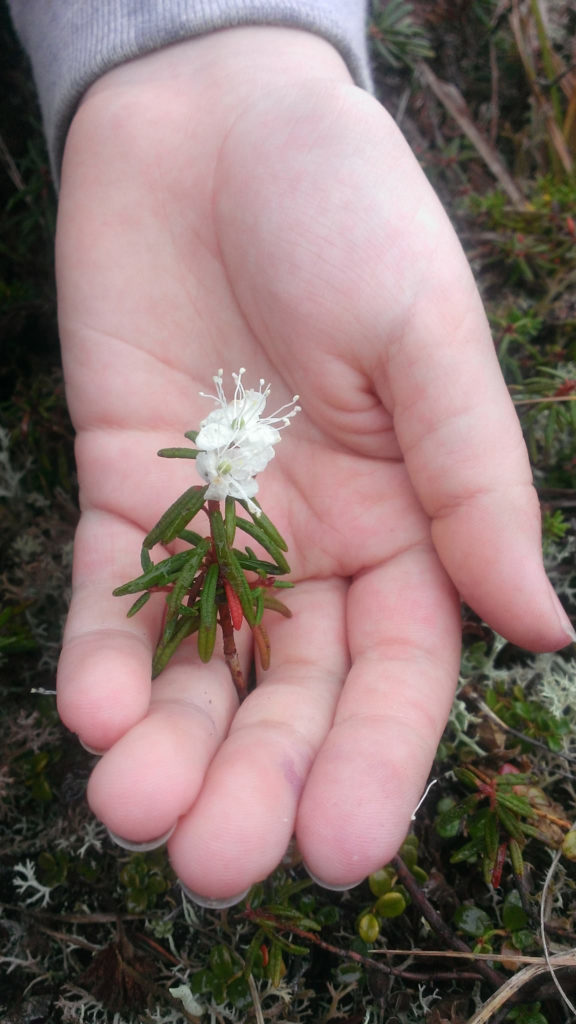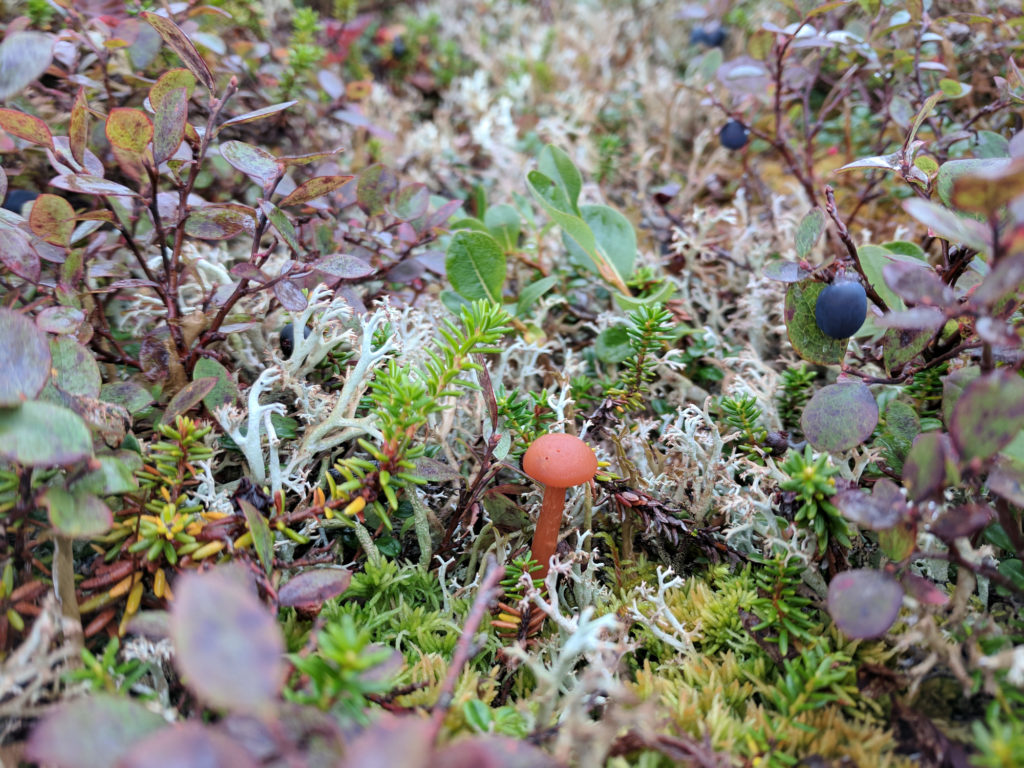Food Sovereignty, A Gift from Our Ancestors

I was born in Nome, Alaska in a land free of fences. Without trees to block the view, the tundra, mountains, oceans, and rivers stretch out endlessly. It feels like all of my early childhood memories are of the country. Winters in the snow, ice fishing, sledding, playing in snow forts my dad made for us. Summers at fish camp, playing on the beach, gathering herbs under the bushes for my mom, picking blueberries and aqpik – in English they are known as cloudberries, plump orange clusters that glisten when ripe.
Looking back now, I took the freedom we had for granted. I returned home to Nome more frequently as a mother wishing to teach my children how to gather and how to love their ancestral homeland. We would explore abandoned houses and pick blueberries next to old Sourdough cabins. Gold prospectors and famous characters like Wyatt Earp come and go but our bonds to the tundra are eternal.
In our story of the creation of the drum, the last mother of the giant eagles mourns for the loss of her children. The Inupiat had no choice but to hunt the giant eagles to stop them from plucking whales out of the sea and only eating the tongues because this wasting of whales was starving the people. The giant eagle mother tells the hunter how to build the first drum and to play it as a reminder of her beating heart.
In my Indigenous worldview, time is cyclical and I see the pattern of heartache repeated in the European hunting of whales of the 1800’s, driven to overharvest for commercial gain. Whales that fed us and shaped our culture of sharing nature’s bounty were nearly exterminated. In Washington State, the Makah Tribe saw the whale population collapse and the tribe decided to suspend whaling until the whales were healthy again. For at least 70 years the Makah stopped their hunt, an entire lifetime of a generation lost as tools, songs, dances, and feasts sat silent.
On May 17, 1999 the Makah Tribe successfully landed a whale and the entire community celebrated as the gift of the whale was revitalized. The general public did not celebrate and more than 400 environmental and animal rights groups materialized to protest, led by people who were ignorant and fettered by their belief that the Save the Whales campaign of the 1970s should also apply to subsistence whale hunting.
I am eternally frustrated by the ignorance of these groups in their interpretation of what matters to Indigenous whaling cultures. During the subsistence whaling moratorium of 1977, a concerned group in California understood that the loss of hunting would be devastating to the northern Native Alaskan communities where western packaged foods are highly priced. The group thought that what the Inupiat communities were going to miss, that what was central to their culture, was the act of killing large animals. They proposed the shipment of live cattle that the Inupiat hunters could kill upon arrival.
For the general public to believe that Indigenous hunters enjoy killing animals is a gross and disgusting interpretation. I grew up with stories of the reverence we must show to the animals that feed us, that we must thank them and pray to them immediately, and that hunters are even taught to apologize the moment that they strike. The act of killing is done out of necessity, not out of what I can only guess these non-Indigenous groups think hunting means (something related to ego, perhaps; or connected to a sense of control of nature, which is also foreign to Indigenous cultures).
Ignorance and arrogance were repeated again in 1999 when Sea Shepherd created a racist campaign calling for violence against the Makah’s reassertion of their treaty right to hunt grey whales. The pattern of the general public not understanding several key facts related to subsistence whaling is something that will be repeated until the public’s attitude towards wanting to govern and assimilate Indigenous people disappears and the attitude of cultural superiority is replaced with empathy.
Food sovereignty is sadly, something that we must define and protect because of the history of an oppressive culture forcibly removing the inherent rights of others to pray, grow, gather, hunt, fish, feed, share, and care for themselves. For me, food sovereignty means cultural revitalization and continuing to support the treaty rights and other legal ways that our ancestors ensured our rights to care for ourselves.
As Native People, we have a duty to follow Natural Law above all else. I teach my children to feel thankfulness while gathering berries, to feel awe and wonder at the bounty that covers the hillsides and valleys, to respect the plants and animals, to take home only what we need for ourselves and for our gifts to share with friends and family.

In movies and in cartoons, I watched the images and heard the messages that the arctic is a desolate place, uncaring, unforgiving, a barren and frozen landscape. I could understand how this view could be true to an outsider. How sad it is, to be so blind to the food and the bounty that is here. I enjoy explaining that the biodiversity in the arctic is tightly packed and presented in miniature versions of a plant’s southern relatives. In the same square foot of tundra there can be mosses, lichen, perennial berries and shrubs, forbs, grasses, fungi, spiders, bumblebees, and rodents. How can our homeland be labelled barren when birds migrate thousands of miles to raise their young here?
The view of nature as ungiving and cruel is a Western cultural worldview and although it is arbitrary this view of nature as restrictive and competitive is stated as scientific fact in primary and secondary curriculums. Pre-contact Indigenous population sizes were presented to me in a wide range of guesses—all based on the assumption that North America couldn’t possibly support significant populations. Ultimately, every landscape from the arctic to the desert to the forest and the coast are presented in textbooks as unable to care for pre-contact Indigenous populations.
I know in my heart that the land loves humanity, and wants to feed us and wants us to take care of her just as she takes care of us. When the lockdown of the pandemic began, I walked in the forests near my house to relieve stress. I found myself looking closer at the plants with the goal of just knowing where to look because I don’t know the traditional foods here as well as I do at home. My efforts would work better if I had an elder to teach and guide me after one of my attempts to gather fiddleheads made me a little nauseous.
Building a good relationship with berries is easier for me and trailing blackberries, one of my favorite PNW native berries, has eluded me for the last twenty years. I knew how delicious and special they are but I would struggle to find enough to store for the winter. The summer of 2020 was the first time that I found a beautiful patch of trailing blackberries, one that was large enough to share with my brother. We wore masks and then happily picked along the patch. My mother was happy for us but she also wished she could have flown down from Alaska and picked with us. Every two to three days I would return to the berry patch and the gift of such special berries was a bright spot during a troubling year.
Although the pandemic kept me from bringing my children to our homeland, I feel a little closer to the plants here. I found a row of tall camas plants growing along both sides of a suburban street and I would walk to them as often as possible while they bloomed and watched for bumblebees visiting. It’s a little hard to tell if the camas are wild or planted but it feels good to see them. I fell even deeper in love with the red flowering currant this year and looked for their blooms during my walks. I also learned that my daughter prefers to pick Alaskan berries because they are tastier and visiting our family makes the berry picking trips more fun. I wouldn’t have known how my daughter felt about home without the pandemic.
I feel blessed to know what food sovereignty means—a deep and true connection to the land—gathering your own food, touching plants, knowing the conditions of the landscape and the weather patterns, thanking plants and animals, bringing home the food and processing it for storage, and sharing the gifts with your family. I am happy to say that I only know what food sovereignty means in the context of a gift economy. All of these steps for accepting nature’s gifts are missing when we simply buy food from the store, there is a physical and emotional distance between us and the land and between us and our families. Food gardening closes this distance some but nothing compares to the humility you feel when you are in a free and wild place and accepting Nature’s gifts directly.
Nature wants to take care of all of us and when we accept nature’s gifts, we need to remember to do it in a way that respects the ancient relationships to homelands that Indigenous people have maintained since time immemorial. Some Indigneous plant foods and medicines are threatened by overharvesting and there are no easy rules for how non-Indigenous peoples can learn to harvest correctly. It’s time to let Indigenous people lead the way towards food sovereignty and I feel protective of our knowledge systems. Our ways of taking care of the land are complex and beautiful and our knowledge is something I’ve never taken for granted, even when I was a little girl learning how to gather herbs for my mother.

Demarus Tevuk (she/her)
Demarus is an Inupiaq from Nome, Alaska and her childhood with Indigenous communities across North America greatly influenced her research on the definition of sustainability from the Indigenous perspective. Demarus earned her degree in Environmental Studies from the University of Washington and she works as an Engagement Strategist with Sustainable Seattle. Demarus loves to pick berries and gather traditional food and she is an avid fiber artist.

